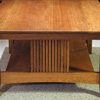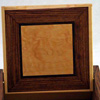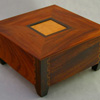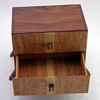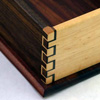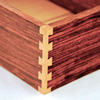The instructions provided on this website are not always detailed enough and are "my way" of doing things. Ask 10 different boat builders or woodworkers how to do 1 thing and you'll get 10 different answers.
!Website Retirement!
I make no income from this site, in fact it costs me a little to run it! I originally created this website when I built my first wooden boat, the website code is now 13 years old, and will require a complete rewrite to continue funtioning properly. With only 25 average daily page views, I feel that the website would not really be missed. If you wish to see this website continue please send an email to me at jim.kubik@jkwoodstudio.com.
Instructions, Tips & Techniques
Two-step Bonding (Primary technique for scarf joints)
Two-step bonding is the preferred method for most situations because it promotes maximum epoxy penetration into the bonding surface and prevents resin-starved joints. Single-step bonding can be used when joints have minimal loads and excess absorption into porous surfaces is not a problem. In both cases, epoxy bonds best when it is worked into the surface with a roller or brush. Before mixing epoxy, check all parts to be bonded for proper fit and surface preparation, gather all the clamps and tools necessary for the operation, and cover any areas that need protection from spills.
- Wet-out bonding surfaces - Apply a neat resin/hardener mixture (without fillers) to the surfaces to be joined. Wet out small or tight areas with a disposable brush. Wet out larger areas with a foam roller or by spreading the resin/hardener mixture evenly over the surface with a plastic spreader. You may proceed with step two immediately or any time before the wet-out coat reaches the final cure stage.
- Apply thickened epoxy to one bonding surface. Modify the resin/hardener mixture by stirring in the appropriate filler (403 for general wood bonding, 404 for hardware bonding, 406 for plywood scarf joints) until it becomes thick enough to bridge any gaps between the mating surfaces and to prevent "resin-starved" joints. Apply enough of the mixture to one of the surfaces, so that a small amount will squeeze out when the surfaces are joined together with a force equivalent to a firm hand grip. Thickened epoxy can be applied immediately over the wet-out surface or any time before the wet-out reaches its final cure. For most small bonding operations, add the filler to the resin/hardener mixture remaining in the batch that was used for the wet-out. Mix enough resin/hardener for both steps. Add the filler quickly after the surface is wet out and allow for a shorter working life of the mixture.
- Clamp components. Attach clamps as necessary to hold the components in place. Use just enough clamping pressure to squeeze a small amount of the epoxy mixture from the joint, indicating that the epoxy is making good contact with both mating surfaces. Avoid using too much clamping pressure, which can squeeze all of the epoxy mixture out of the joint.
- Remove or shape excess adhesive that squeezes out of the joint as soon as the joint is secured with clamps. A wooden mixing stick with one end sanded to a chisel edge is an ideal tool for removing the excess.
Single-step bonding
Single-step bonding is applying the thickened epoxy directly to both bonding surfaces without first wetting out the surfaces with neat resin/hardener. We recommend that you thicken the epoxy no more than is necessary to bridge gaps in the joint (the thinner the mixture, the more it can penetrate the surface) and that you do not use this method for highly-loaded joints or for bonding end grain or other porous surfaces.
Laminating
The term "laminating" refers to the process of bonding numbers of relatively thin layers, like plywood, veneers, fabrics or core material to create a composite. A composite may be any number of layers of the same material or combinations of different materials. Methods of epoxy application and clamping will differ depending on what you are laminating. Because of large surface areas and limitations of wet lay-up time, roller application is the most common method for applying epoxy. A faster method for large surfaces is to simply pour the resin/hardener mixture onto the middle of the panel and spread the mixture evenly over the surface with a plastic spreader. Apply thickened mixtures with an 809 Notched Spreader. Using staples or screws is the most common method of clamping when you laminate a solid material to a solid substrate. An even distribution of weights will work when you are laminating a solid material to a base that will not hold staples or screws, such as a foam or honeycomb core material. Vacuum bagging is the ideal clamping method for laminating a wide range of materials. Through the use of a vacuum pump and plastic sheeting, the atmosphere is used to apply perfectly even clamping pressure over all areas of a panel regardless of the size, shape or number of layers.
* This information is copied directly from the West System Epoxy manual.
Hull Sides & Bottom
- Check ends to be scarfed for square and parallel edges.
- Scarf should be cut to an 8° angle.
- When scarf cut is complete all 5 ply's should be visible.
- Ply's to be scarfed on both ends require scarfs cuts on opposite sides of the ply.
- Use two-step bonding with epoxy for joints.
- Clamp with enough pressure to create some squeeze out, do not apply too much pressure which could squeeze out most of the epoxy.
- Cut ribs from 6/4 stock (see cut list).
- Check each rib for straightness and torque, slightly curved ones can be used for the shorter ribs near the bow. Do not use severely torqued ribs.
- Lay ribs in place on hull sides, number each and mark each rib for port and starboard.
- Fit ribs by making progressively smaller cuts, ensuring the ribs are lined up vertically with the rib lines.
- After each rib is cut, tack in place, make sure you step back and check hull lines. Adjust ribs if necessary.
- After all ribs are tacked in place carefully check hull lines, any problems now will lead to much more severe problems later.
- Attach each rib with glue and 2½" ring shanks. Note the placement of the ring shanks since you will be driving more nails into the rib when attaching the chine.
Mold, Ribs & Bow
- Measure total length of ply (approximately 18’ 6" for a 18’ skiff).
- Divide by 3, the result is the measurement from the bow end to the mold line.
- Draw a vertical mold line with a framing square the complete width of the ply.
- Measure 3" towards the aft end and draw another vertical line, this is a rib line.
- Draw all other rib lines by measuring 16" on center from the 1st rib line.
- Draw a line 3/4" forward and aft of each rib line to show the outside edges of each 1½" horizontal rib.
- The center rib lines are used for a guide when attaching the vertical ribs.
- Measure 12" from the bow end along the bottom edge of the stacked plys, make a mark.
- Draw the bow angle cut line with a straight edge.
- From the bottom edge 12" mark, draw a line to the top edge point.
- While the plys (hull sides) are still stacked and on saw horses, use a circular saw to cut through both plys along the bow angle cut line.
- Start with a solid piece of wood 72" x 48" x 1½" (can also be made from a laminate, see cut list).
- Mark the forward and aft face and measure for 3 lines; 1 line in the center from bottom to top, 2 marks 23" to the left and right of the center line along the bottom.
- From the 2 marks in the previous step measure straight up 12" and at a 90° angle over 4" away form the center line and make another mark.
- You should now have 4 marks, 2 on each side of the center line. Using a straight edge draw a line from bottom to top through each mark. These lines will be the angled cut lines forming the outside edges of the transom.
- Cut along the bottom line at a 15° angle with the angle towards the aft. When the transom is leaned towards the rear at 15° the bottom angle should be parallel to the ground.
- Cut along both side lines at a 12° angle. This angle should run from forward to aft with the forward edge of the transom being slightly wider than the aft.
- Attach to the hull sides before shaping any further.
- After attaching the sheerstrake, set a framing square flush against the inside of the hull and flat against the transom, draw a line where the right angle crosses over the top of the transom. This is the 1st cut line for shaping the transom. This should be cut at 15°, so that the top of the cut is parallel to the bottom of the transom.
- Cut ribs from 4/4 stock (see cut list). Shape with template and flush trim bit on a router table. All ribs need to be identical.
- Lay ribs in place on hull sides, number each and mark each rib for port and starboard.
- Put a rib in place flat on the forward side of a horizontal rib (5th or 6th rib) and firmly against the hull, adjust up and down so that approximately 3/4" of the base the vertical rib extends above the horizontal rib (interior not above bottom of rib), draw a cut line on the vertical rib along the horizontal rib. Draw another line on the edge of the rib where the rib extends below the hull. Draw the same lines on all ribs.
- On a miter saw cutoff excess of each rib base at the cut line from the previous step.
- Along one hull side, one at a time, lay each rib in place against the hull side, make progressive cuts on a jointer changing the angle of the jointer until the rib lays flush against the hull and the horizontal rib. After the final cut on the jointer take the rib from the opposite side of the boat and make progressive cuts on the jointer using the angle already set starting the cut from the opposite end of the rib. Since the hull should be symmetrical the opposite side rib should fit very closely.
NOTE: The direction of the cuts on the jointer will change to the opposite direction around the 7th rib due to the change in the curve of the hull. - One at a time, take each rib, set it in place and use the rib line on the inside of the hull to line it up. Draw a vertical line on the outside of the hull where the start and finish of the line is the center of the vertical rib at the top and bottom. This will be your nail line.
- One at a time apply glue to the face of the base and the edge of the rib where it will attach to the horizontal rib and the hull. Clamp in place so that the top of the rib is flush with the top of the horizontal rib and the jointed edge is flush against the hull. Pre-drill the base with 4 holes for ring shanks that will attach the vertical rib to the horizontal rib, be careful with the placement of the holes to avoid splitting the base of the rib.
- Drive only 1 nail in the base to allow movement of the rib while nailing to the hull.
- Start a 1" ring shank on the nail line 1" from the bottom edge of the hull (actually the top edge of hull but the boat should be upside down at this time). Grab the bottom of the rib that is exposed below the hull and pull outward with slight pressure and finish driving the nail you already started. Continue driving nails through the hull on the nail line into the rib using progressively larger nails as you move up the hull.
- Drive the remaining 3 nails into the pre-drilled holes in the base securing the vertical rib to the horizontal rib. Remove the clamps and move on to the next vertical rib.
- Repeat steps 7 - 10 until all ribs are installed.

